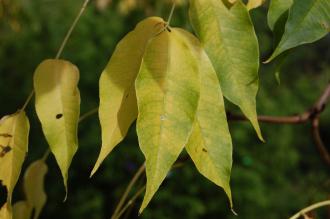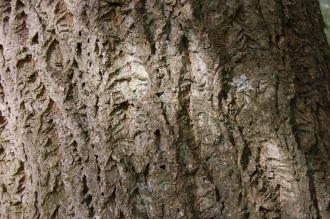
Phellodendron amurense (28/09/2014, Kew Gardens, London)
Position: Full sun
Flowering period: Late spring
Soil: Moist, well drained
Eventual Height: 15m
Eventual Spread: 20m
Hardiness: 3a, 3b, 4a, 4b, 5a, 5b, 6a, 6b, 7a, 7b, 8a, 8b
Family: Rutaceae
Phellodendron amurense is a deciduous tree with a rounded spreading habit . Its mid green leaves are odd pinnate with up to 11 leaflets and are aromatic when crushed. Its leaflets are ovate with entire margins, up to 11cm long and 4cm broad. Its leaves turn yellow before they fall in autumn. Its branches. Its grey/ brown bark is ridged and corky in mature trees. This tree is dioecious and its yellow/ green flowers are up to 2mm across. Its black fruit is a fleshy drupe which is up to 1cm across and persist into the winter months.

Phellodendron amurense Leaf (28/09/2014, Kew Gardens, London)
Phellodendron amurense, commonly known as Amur Cork tree, is native to east Asia, including north China, Manchuria, Korea, Ussuri Amur and Japan. In its native habitat it grows in deciduous woodland. This tree is considered as invasive in many parts of the USA and Canada. This tree will readily reseed given the right conditions.
The etymological root of the binomial name Phellodendron is derived from the Greek phellos meaning ‘cork’ and dendron meaning ‘tree’. Amurense is derived from the Latin and means ‘from the region of the Amur River, east Siberia’.
The landscape architect may find Phellodendron amurense useful as an attractive parkland tree. Once established this tree is drought tolerant.

Phellodendron amurense Bark (28/09/2014, Kew Gardens, London)
Ecologically, Phellodendron amurense fruit are attractive to some birds.
Phellodendron amurense prefers moist, humus rich, well-drained soils. It tolerates most pH of soil.
Phellodendron amurense requires little maintenance.

